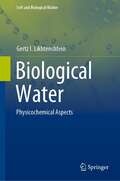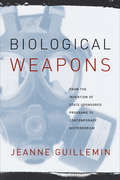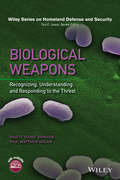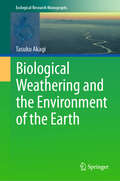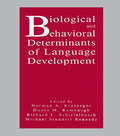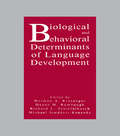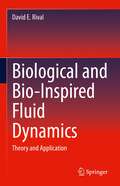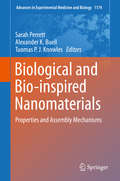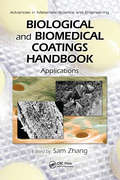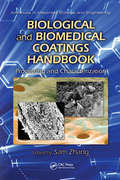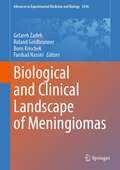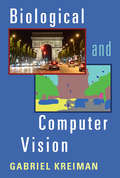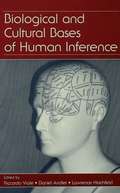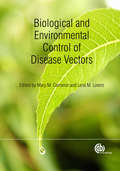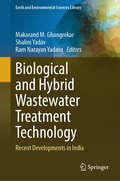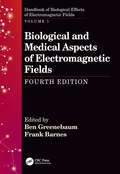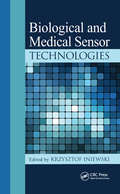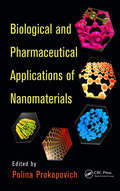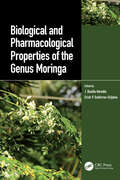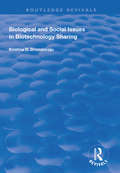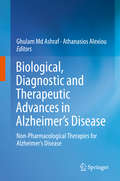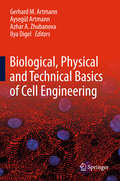- Table View
- List View
Biological Water: Physicochemical Aspects (Soft and Biological Matter)
by Gertz I. LikhtenshteinThis book embraces all physiochemical aspects of the structure and molecular dynamics of water, focusing on its role in biological objects, e.g. living cells and tissue, and in the formation of functionally active structures of biological molecules and their ensembles. Water is the single most abundant chemical found in all living things. It offers a detailed look into the latest modern physical methods for studying the molecular structure and dynamics of the water and provides a critical analysis of the existing literature data on the properties of water in biological objects. Water as a chemical reagent and as a medium for the formation of conditions for enzymatic catalysis is a core focus of this book. Although well suited for active researchers, the book as a whole, as well as each chapter on its own, can be used as fundamental reference material for graduate and undergraduate students throughout chemistry, physics, biophysics and biomedicine.
Biological Weapons: From the Invention of State-Sponsored Programs to Contemporary Bioterrorism (Columbia Contemporary Issues In National Security Policy)
by Jeanne GuilleminUntil the events of September 11 and the anthrax attacks of 2001, biological weapons had never been a major public concern in the United States. Today, the possibility of their use by terrorists against Western states looms large as an international security concern. In Biological Weapons, Jeanne Guillemin provides a highly accessible and compelling account of the circumstances under which scientists, soldiers, and statesmen were able to mobilize resources for extensive biological weapons programs and also analyzes why such weapons, targeted against civilians, were never used in a major conflict. This book is essential for understanding the relevance of the historical restraints placed on the use of biological weapons for today's world. It serves as an excellent introduction to the problems biological weapons pose for contemporary policymakers and public officials, particularly in the United States. How can we best deter the use of such weapons? What are the resulting policies of the Department of Homeland Security? How can we constrain proliferation? Jeanne Guillemin wisely points out that these are vitally important questions for all Americans to consider and investigate—all the more so because the development of these weapons has been carried out under a veil of secrecy, with their frightening potential open to exploitation by the media and government. Public awareness through education can help calm fears in today's tension-filled climate and promote constructive political action to reduce the risks of a biological weapons catastrophe.Biological Weapons is required reading for every concerned citizen, government policymaker, public health official, and national security analyst who wants to understand this complex and timely issue.
Biological Weapons: Recognizing, Understanding, and Responding to the Threat
by Ted E. Lewis Kristy Young Johnson Paul Matthew NolanGives readers a detailed understanding of how specific biological weapons work and how those affected by the weapons would be treated Teaches the reader to recognize the symptoms of each biological weapon and understand the threat these weapons pose Concentrates on the weapons considered the greatest threats by the CDC such as Anthrax, Botulism, Smallpox, Ricin toxin, Ebola, Plague, and Viral encephalitis Provides a detailed understanding of how specific biological weapons work and how to recognize the symptoms of those affected by the weapons as well as how they would be treated Includes case studies, chapter review questions, and the instructor's supplemental materials include PowerPoint presentations, a Test Bank, and suggestions for student projects Begins with a primer on microbiology, the human immune system's response to these biological agents, and the defense agencies involved with protecting the public against these agents
Biological Weathering and the Environment of the Earth (Ecological Research Monographs)
by Tasuku AkagiThis book introduces the concept of 'biological weathering.' Weathering, especially chemical weathering, has been recognized as one of the most important processes on Earth because it influences the circulation of elements, including carbon. Weathering has almost always been considered an abiotic process. The book describes the author’s experiments, proving that plant involvement in weathering is a strategy for plants to ingest nutrients from rocks. It is also shown through cultivation experiments and observation of natural diatoms that diatoms and silica obligate plankton dissolve silicate minerals and incorporate silicon and other elements into their frustules. The weathering reaction has also been successfully applied to the previously unexplained relationship between carbon and silica in the ocean’s interior. Readers of this book will gain a comprehensive understanding of weathering as a reaction catalyzed by both plants and plankton, occurring not only on land but also ubiquitously in the earth’s environment, including the ocean’s interior. This new and novel perspective has significant implications for various scientific fields, including biology, marine chemistry, environmental, and paleoenvironmental sciences. The author underscores the immediate relevance of these findings to pressing issues surrounding atmospheric CO2. The book concludes with a proposal for an efficient and safe method to sequester CO2 in the atmosphere into the ocean interior, offering a practical solution to a global challenge. The target audience for this book includes students and researchers in ecology, evolutionary biology, geochemistry, environment and plant sciences, atmospheric sciences, and Geo-industries.
Biological and Behavioral Determinants of Language Development
by Duane M. Rumbaugh Norman A. Krasnegor Richard L. Schiefelbusch Michael Studdert-KennedyThis book presents a current, interdisciplinary perspective on language requisites from both a biological/comparative perspective and from a developmental/learning perspective. Perspectives regarding language and language acquisition are advanced by scientists of various backgrounds -- speech, hearing, developmental psychology, comparative psychology, and language intervention. This unique volume searches for a rational interface between findings and perspectives generated by language studies with humans and with chimpanzees. Intended to render a reconsideration as to the essence of language and the requisites to its acquisition, it also provides readers with perspectives defined by various revisionists who hold that language might be other than the consequence of a mutation unique to humans and might, fundamentally, not be limited to speech.
Biological and Behavioral Determinants of Language Development
by Duane M. Rumbaugh Norman A. Krasnegor Richard L. Schiefelbusch Michael Studdert-KennedyThis book presents a current, interdisciplinary perspective on language requisites from both a biological/comparative perspective and from a developmental/learning perspective. Perspectives regarding language and language acquisition are advanced by scientists of various backgrounds -- speech, hearing, developmental psychology, comparative psychology, and language intervention. This unique volume searches for a rational interface between findings and perspectives generated by language studies with humans and with chimpanzees. Intended to render a reconsideration as to the essence of language and the requisites to its acquisition, it also provides readers with perspectives defined by various revisionists who hold that language might be other than the consequence of a mutation unique to humans and might, fundamentally, not be limited to speech.
Biological and Bio-Inspired Fluid Dynamics: Theory and Application
by David E. RivalThis text provides the reader with tools necessary to study biological and bio-inspired flows, all the while developing an appreciation for their evolutionary and engineering constraints. It is suitable for students already exposed to introductory concepts in fluid mechanics and applied mechanics as a whole, but who would not need an advanced training in fluid mechanics per se. Currently no textbook exists that can take students from an introductory position in fluid mechanics to these contemporary topics of interest. The book is ideal for upper-level undergraduates and graduate students studying a range of engineering domains as well as biology, or even medicine.
Biological and Bio-inspired Nanomaterials: Properties and Assembly Mechanisms (Advances in Experimental Medicine and Biology #1174)
by Sarah Perrett Alexander K. Buell Tuomas P. J. KnowlesThis book summarizes naturally occurring and designed bio-inspired molecular building blocks assembled into nanoscale structures. It covers a fascinating array of biomimetic and bioinspired materials, including inorganic nanozymes, structures formed by DNA origami, a wide range of peptide and protein-based nanomaterials, as well as their applications in diagnostics and therapeutics. The book elucidates the mechanism of assembly of these materials and characterisation of their mechanical and physico-chemical properties which inspires readers not only to exploit the potential applications of nanomaterials, but also to understand their potential risks and benefits. It will be of interest to a broad audience of students and researchers spanning the disciplines of biology, chemistry, engineering, materials science, and physics.
Biological and Biomedical Coatings Handbook: Applications (Advances in Materials Science and Engineering)
by Sam ZhangWritten in a versatile, contemporary style that will benefit both novice and expert alike, Biological and Biomedical Coatings Handbook, Two-Volume Set covers the state of the art in the development and implementation of advanced thin films and coatings in the biological field. Consisting of two volumes-Processing and Characterization and Applicatio
Biological and Biomedical Coatings Handbook: Processing and Characterization
by Sam ZhangWritten in a versatile, contemporary style that will benefit both novice and expert alike, Biological and Biomedical Coatings Handbook, Two-Volume Set covers the state of the art in the development and implementation of advanced thin films and coatings in the biological field. Consisting of two volumes-Processing and Characterization and Applicatio
Biological and Clinical Landscape of Meningiomas (Advances in Experimental Medicine and Biology #1416)
by Gelareh Zadeh Roland Goldbrunner Boris Krischek Farshad Nassiri"Meningiomas are tumors that originate from the arachnoidal cap cells of the leptomeninges. With an incidence rate of 8.36 per 100, 000 population, they are the most common primary central nervous system (CNS) tumors, accounting for a third of all cases. The World Health Organization (WHO) classification has traditionally categorized meningiomas into 15 different histopathological subtypes and three clinical grades. Tumors are classified as WHO grades 1, 2 or 3 based largely on histopathological features such as mitotic activity, presence of brain invasion, and other atypical features. However, there is increasing recognition of the limitations of histopathology including but not limited to: confounding factors such as sampling bias in a heterogeneous tumor, and technical factors related to the experience of the grading pathologist. Even with careful histologic grading, there remains significant variability in recurrence rates within each tumor grade. As more studies have uncovered the molecular features of meningiomas, novel biological alterations have helped refine classification schemes that more accurately reflect patient outcomes. This book reviews the current state of knowledge on the genomic and epigenomic landscape of meningiomas in order to identify the roles of genomic aberrations on diagnosis, prognosis, and treatment of meningiomas in addition to mainstays of surgical management, radiation therapy, and potential novel chemotherapies. Written by a team of world-renowned experts in neurosurgery, neuropathology, radiology, and radiation-oncology, this book is the definitive resource on meningioma management and investigation for both clinicians and scientists alike."
Biological and Computer Vision
by Gabriel KreimanImagine a world where machines can see and understand the world the way humans do. Rapid progress in artificial intelligence has led to smartphones that recognize faces, cars that detect pedestrians, and algorithms that suggest diagnoses from clinical images, among many other applications. The success of computer vision is founded on a deep understanding of the neural circuits in the brain responsible for visual processing. This book introduces the neuroscientific study of neuronal computations in visual cortex alongside of the psychological understanding of visual cognition and the burgeoning field of biologically-inspired artificial intelligence. Topics include the neurophysiological investigation of visual cortex, visual illusions, visual disorders, deep convolutional neural networks, machine learning, and generative adversarial networks among others. It is an ideal resource for students and researchers looking to build bridges across different approaches to studying and developing visual systems.
Biological and Cultural Bases of Human Inference
by Riccardo Viale Daniel Andler Lawrence HirschfeldBiological and Cultural Bases of Human Inference addresses the interface between social science and cognitive science. In this volume, Viale and colleagues explore which human social cognitive powers evolve naturally and which are influenced by culture. Updating the debate between innatism and culturalism regarding human cognitive abilities, this book represents a much-needed articulation of these diverse bases of cognition. Chapters throughout the book provide social science and philosophical reflections, in addition to the perspective of evolutionary theory and the central assumptions of cognitive science. The overall approach of the text is based on three complementary levels: adult performance, cognitive development, and cultural history and prehistory. Scholars from several disciplines contribute to this volume, including researchers in cognitive, developmental, social and evolutionary psychology, neuropsychology, cognitive anthropology, epistemology, and philosophy of mind. This contemporary, important collection appeals to researchers in the fields of cognitive, social, developmental, and evolutionary psychology and will prove valuable to researchers in the decision sciences.
Biological and Environmental Control of Disease Vectors
by Steve Lindsay Ulrike Fillinger Yen Nguyen Mary Cameron Jo Lines S Ghosh Sandy Cairncross Lena Lorenz Sarah Moore Bart Knols Annabel HowardCovering the theory and practice of non-insecticidal control of insect vectors of human disease, this book provides an overview of methods including the use of botanical biocides and insect-derived semiochemicals, with an overall focus on integrated vector management strategies. While the mainstay of malaria control programmes relies on pesticides, there is a resurgence in the research and utilisation of non-insecticidal control measures due to concerns over rapid development and spread of insecticide resistance, and long-term environmental impacts. This book provides examples of successful applications in the field and recommendations for future use.
Biological and Environmental Control of Disease Vectors
by Steve Lindsay Ulrike Fillinger Yen Nguyen Jo Lines S Ghosh Sandy Cairncross Sarah Moore Bart Knols Annabel HowardCovering the theory and practice of non-insecticidal control of insect vectors of human disease, this book provides an overview of methods including the use of botanical biocides and insect-derived semiochemicals, with an overall focus on integrated vector management strategies. While the mainstay of malaria control programmes relies on pesticides, there is a resurgence in the research and utilisation of non-insecticidal control measures due to concerns over rapid development and spread of insecticide resistance, and long-term environmental impacts. This book provides examples of successful applications in the field and recommendations for future use.
Biological and Hybrid Wastewater Treatment Technology: Recent Developments in India (Earth and Environmental Sciences Library)
by Shalini Yadav Ram Narayan Yadava Makarand M. GhangrekarThis book provides technical information on different biological and hybrid wastewater treatment systems for the treatment of wastewater and reuse, and tracks their progress towards practical and field-scale applications including strategies to be adopted for minimizing the losses and maximizing the benefits, as well as protecting the environment through the application of advanced biological and hybrid wastewater treatment Technology. In addition, it discusses the crucial parts that science, technology, and innovation play in the formulation, implementation, and administration of wastewater treatment policy. It highlights the challenges that must be overcome to adopt biological and hybrid wastewater treatment infrastructure regulations successfully and provides some answers. Also, it investigates how the biological and hybrid wastewater treatment technology may be used in a wide variety of field's sets apart from other on-the-shelf publications on the market. Also, it delves into the core concepts of Biological and Hybrid Wastewater Treatment Systems. It explores how these concepts can be modified to fit a variety of contexts and uses. Applications such as managing facilities, dealing with pandemics, urban wastewater treatment and reuse, farming, and other applications are included in this book. As a consequence, this book's content is engaging, and it will pique the interest of a diverse audience of readers who come from a wide variety of different professional backgrounds. Therefore, the book is written by local experts in the topic who dealing with the treatment of wastewater treatment technologies for a long time in India. This book will be helpful to researchers, entrepreneurs, professionals, planners, policymakers, environmental engineers, and others interested in biological and hybrid wastewater treatment system management strategies through the application of breakthroughs in biological and hybrid wastewater treatment technologies.
Biological and Medical Aspects of Electromagnetic Fields, Fourth Edition (Handbook of Biological Effects of Electromagnetic Fields)
by Frank Barnes Ben GreenebaumThe two volumes of this new edition of the Handbook cover the basic biological, medical, physical, and electrical engineering principles. They also include experimental results concerning how electric and magnetic fields affect biological systems—both as potential hazards to health and potential tools for medical treatment and scientific research. They also include material on the relationship between the science and the regulatory processes concerning human exposure to the fields. Like its predecessors, this edition is intended to be useful as a reference book but also for introducing the reader to bioelectromagnetics or some of its aspects. FEATURES • New topics include coverage of electromagnetic effects in the terahertz region, effects on plants, and explicitly applying feedback concepts to the analysis of biological electromagnetic effects • Expanded coverage of electromagnetic brain stimulation, characterization and modeling of epithelial wounds, and recent lab experiments on at all frequencies • Section on background for setting standards and precautionary principle • Discussion of recent epidemiological, laboratory, and theoretical results; including: WHO IARC syntheses of epidemiological results on both high and low frequency fields, IITRI lab study of cancer in mice exposed to cell phone-like radiation, and other RF studies • All chapters updated by internationally acknowledged experts in the field
Biological and Medical Sensor Technologies (Devices, Circuits, and Systems)
by Krzysztof IniewskiBiological and Medical Sensor Technologies presents contributions from top experts who explore the development and implementation of sensors for various applications used in medicine and biology. Edited by a pioneer in the area of advanced semiconductor materials, the book is divided into two sections. The first part covers sensors for biological applications. Topics include: Advanced sensing and communication in the biological world DNA-derivative architectures for long-wavelength bio-sensing Label-free silicon photonics Quartz crystal microbalance-based biosensors Lab-on-chip technologies for cell-sensing applications Enzyme biosensors Future directions for breath sensors Solid-state gas sensors for clinical diagnosis The second part of the book deals with sensors for medical applications. This section addresses: Bio-sensing and human behavior measurements Sweat rate wearable sensors Various aspects of medical imaging The future of medical imaging Spatial and spectral resolution aspects of semiconductor detectors in medical imaging CMOS SSPM detectors CdTe detectors and their applications to gamma-ray imaging Positron emission tomography (PET) Composed of contributions from some of the world’s foremost experts in their respective fields, this book covers a wide range of subjects. It explores everything from sensors and communication systems found in nature to the latest advances in manmade sensors. The end result is a useful collection of stimulating insights into the many exciting applications of sensor technologies in everyday life.
Biological and Neuroscientific Foundations of Philosophy: Towards a New Paradigm
by Franco FabbroBiological and Neuroscientific Foundations of Philosophy is an authoritative text addressing both academicians and students, and it proposes an integrated and holistic view of scientific study and presents a new paradigm by which to study philosophy. It highlights, in a systematic and sufficiently simple manner, the fundamental role of neuroscience, neuropsychology and biology within philosophical reflection. Written by an expert in neuroscience, the book draws together different strands of study to explore how scientific and neuropsychological discoveries are integral to the study of philosophy and our understanding of mind. It argues to move away from a philosophical paradigm that is based solely within physics and mathematics and to embrace more complex frames of data and knowledge of psychology and biology to advance the discipline. The book also reflects on the symbolic dimensions and the concept of "information" that characterize DNA (biology), and the psyche and language (cognitive and social neuroscience). It offers an ambitious thesis that ties together the philosophical foundations of science, the evolutionary history of human beings, social organization, communication and consciousness. This interdisciplinary work will be highly beneficial for researchers and postgraduate students of neuroscience, philosophy and biological sciences, as well as those interested in the intersection between philosophy and neuroscience.
Biological and Pharmaceutical Applications of Nanomaterials
by Polina ProkopovichBiological and Pharmaceutical Applications of Nanomaterials presents the findings of cutting-edge research activities in the field of nanomaterials, with a particular emphasis on biological and pharmaceutical applications. Divided into four sections-nanomaterials for drug delivery, antimicrobial nanomaterials, nanomaterials in biosensors, and safet
Biological and Pharmacological Properties of the Genus Moringa
by J. Basilio HerediaThere is an increasing interest in plants of the Moringa genus used as a source of phytochemicals with biopharmaceutical potential, as a functional ingredient in many products and as an additive in poultry feeding stocks. Biological and Pharmacological Properties of the Genus Moringa is the first publication to comprehensively assess the latest research on Moringa studies. This book reviews recent studies covering the botanical, agronomical, genomic, biotechnological, and ethnopharmacological aspects. It presents specialized work in a user-friendly way that will appeal to undergraduates, graduates and researchers primarily in ethnopharmacology, functional foods and with a linkage to veterinary treatments. Key Features: Describes the ethnopharmacological and ethnobotanical use of plants from all Moringa species Presents recent information that will be helpful for the future development of biopharmaceuticals Reviews the phytochemical content from all Moringa species Assesses the potential of all Moringa species as a functional ingredient
Biological and Social Issues in Biotechnology Sharing (Routledge Revivals)
by Krishna R. DronamrajuFirst published in 1998, this was the first book to present a comprehensive summary of both the global as well as institutional issues which are involved in biotechnology sharing. It covers the controversial subject of intellectual property rights (IPR) and the patenting of new discoveries in genetic knowledge in both agriculture and the human genome. One controversial issue is the creation of public and private DNA sequencing data bases. Of special interest is the sharing of biotechnology between the developed (rich) and developing (poor) nations. A related topic which requires immediate attention is the exploitation of biodiversity in the developing countries and the resulting extinction of rare species. Sharing or transferring biotechnology and its applications between institutions or different countries raises numerous ethical and moral dilemmas. A comprehensive summary of these issues is presented in this book.
Biological sequence analysis
by Richard Durbin Sean R. Eddy Anders Krogh Graeme MitchisonProbabilistic models are becoming increasingly important in analysing the huge amount of data being produced by large-scale DNA-sequencing efforts such as the Human Genome Project. For example, hidden Markov models are used for analysing biological sequences, linguistic-grammar-based probabilistic models for identifying RNA secondary structure, and probabilistic evolutionary models for inferring phylogenies of sequences from different organisms. This book gives a unified, up-to-date and self-contained account, with a Bayesian slant, of such methods, and more generally to probabilistic methods of sequence analysis. Written by an interdisciplinary team of authors, it aims to be accessible to molecular biologists, computer scientists, and mathematicians with no formal knowledge of the other fields, and at the same time present the state-of-the-art in this new and highly important field.
Biological, Diagnostic and Therapeutic Advances in Alzheimer's Disease: Non-Pharmacological Therapies for Alzheimer's Disease
by Athanasios Alexiou Ghulam Md AshrafThis book discusses the latest research into the highly prevalent neurodevelopmental disease most commonly associated with aging: Alzheimer’s disease (AD). Even after years of research, Alzheimer’s disease is still far from being cured. It presents a range of common symptoms in the form of behavioral and cognitive impairments. This book describes the symptoms and the biology behind them. The contents covers latest findings on the genetics involved and various factors and pathways influencing disease development. It also covers various non-pharmacological therapies like immunotherapy, use of natural products, and employing nanotechnology in both the detection and treatment of AD. This book also highlights the role of diet and nutrition in healthy aging. Given its scope, it offers a valuable asset for researchers and clinicians alike.
Biological, Physical and Technical Basics of Cell Engineering
by Gerhard M. Artmann Aysegül Artmann Azhar A. Zhubanova Ilya DigelThis book presents and discusses recent scientific progress on Cell and Stem Cell Engineering. It predominantly focuses on Biological, Physical and Technical Basics, and features new trends of research reaching far into the 21st century.
